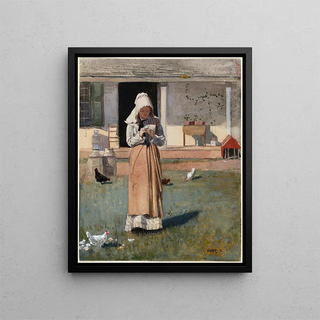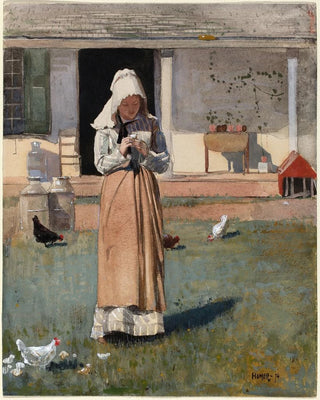Art print | A sick chicken - Winslow Homer


View from behind

Frame (optional)
In the fascinating world of art, some works transcend their era to become timeless witnesses to the human condition. "Un poulet malade - Winslow Homer" is one of those creations that captivate with their emotional depth and striking realism. This piece, painted at the end of the 19th century, evokes not only the fragility of life but also the complex relationship between humans and nature. Homer's art, recognized for its ability to capture light and atmosphere, immerses us here in a moment of reflection and tenderness. Through the viewer's gaze, the sick chicken becomes a symbol of universal vulnerability, an invitation to contemplate our own existence.
Style and uniqueness of the work
Winslow Homer's style is distinguished by its ability to blend realism with poetic sensitivity. In "Un poulet malade," the composition is both simple and evocative. The artist uses earthy colors and delicate shades to create an intimate atmosphere, where every detail matters. The tired look of the bird, the texture of the feathers, and even the blurred background contribute to a total immersion in the painting. Homer excels in depicting emotions, and here, he succeeds in conveying a gentle melancholy, a reflection on life's fragility. The play of light and shadow, characteristic of his work, enhances this sense of closeness to the subject, making the piece almost tangible.
The artist and his influence
Winslow Homer, an iconic figure of American art, knew how to mark his era with an innovative approach to painting. Born in 1836, he began his career as an illustrator before turning to oil painting. His on-the-ground experience, notably during the Civil War, profoundly influenced his work, allowing him to capture moments of truth with rare intensity. Homer's sensitivity to nature and American rural life is evident in every canvas, making him a pioneer of American realism. His influence endures today, inspiring many contemporary artists to explore themes of nature, solitude, and the human condition through an authentic and touching lens.

Matte finish

View from behind

Frame (optional)
In the fascinating world of art, some works transcend their era to become timeless witnesses to the human condition. "Un poulet malade - Winslow Homer" is one of those creations that captivate with their emotional depth and striking realism. This piece, painted at the end of the 19th century, evokes not only the fragility of life but also the complex relationship between humans and nature. Homer's art, recognized for its ability to capture light and atmosphere, immerses us here in a moment of reflection and tenderness. Through the viewer's gaze, the sick chicken becomes a symbol of universal vulnerability, an invitation to contemplate our own existence.
Style and uniqueness of the work
Winslow Homer's style is distinguished by its ability to blend realism with poetic sensitivity. In "Un poulet malade," the composition is both simple and evocative. The artist uses earthy colors and delicate shades to create an intimate atmosphere, where every detail matters. The tired look of the bird, the texture of the feathers, and even the blurred background contribute to a total immersion in the painting. Homer excels in depicting emotions, and here, he succeeds in conveying a gentle melancholy, a reflection on life's fragility. The play of light and shadow, characteristic of his work, enhances this sense of closeness to the subject, making the piece almost tangible.
The artist and his influence
Winslow Homer, an iconic figure of American art, knew how to mark his era with an innovative approach to painting. Born in 1836, he began his career as an illustrator before turning to oil painting. His on-the-ground experience, notably during the Civil War, profoundly influenced his work, allowing him to capture moments of truth with rare intensity. Homer's sensitivity to nature and American rural life is evident in every canvas, making him a pioneer of American realism. His influence endures today, inspiring many contemporary artists to explore themes of nature, solitude, and the human condition through an authentic and touching lens.






